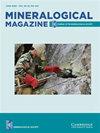Chrysoberyl and associated beryllium minerals resulting from metamorphic overprinting of the Maršíkov–Schinderhübel III pegmatite, Czech Republic
IF 1.4
3区 地球科学
Q2 MINERALOGY
引用次数: 0
Abstract
Abstract The Maršíkov–Schinderhübel III pegmatite in the Hrubý Jeseník Mountains, Silesian Domain, Czech Republic, is a classic example of chrysoberyl-bearing LCT granitic pegmatite of beryl–columbite subtype. This thin pegmatite dyke, (up to 1 m in thickness in biotite–amphibole gneiss is characterised by symmetrical internal zoning. Tabular and prismatic chrysoberyl crystals (≤3 cm) occur typically in the intermediate albite-rich unit and rarely in the quartz core. Chrysoberyl microtextures are quite complex; their crystals are irregularly patchy, concentric or fine oscillatory zoned with large variations in Fe content (1.1–5.3 wt.% Fe2O3; ≤0.09 apfu). Chrysoberyl compositions reveal dominant Fe3+ = Al3+ and minor Fe2+ + Ti4+ = 2(Al, Fe)3+ substitution mechanisms in the octahedral sites. Tin, Ga, and V (determined by LA-ICP-MS) are characteristic trace elements incorporated in the chrysoberyl structure, whereas anomalously high Ta and Nb concentrations (thousands ppm) in chrysoberyl are probably caused by nano- to micro-inclusions of Nb–Ta oxide minerals; especially columbite–tantalite. Textural relationships between associated minerals, distinct schistosity of the pegmatite parallel to the host gneiss foliation and fragmentation of the pegmatite body into blocks as a result of superimposed stress are clear evidence for deformation and metamorphic overprinting of the pegmatite. Primary magmatic beryl, albite and muscovite were transformed to chrysoberyl, fibrolitic sillimanite, secondary quartz and muscovite during a high-temperature (~600°C) and medium-pressure (~250–500 MPa) prograde metamorphic stage under amphibolite-facies conditions. A subsequent retrograde, low-temperature (~200–500°C) and pressure (≤250 MPa) metamorphic stage resulted in the local alteration of chrysoberyl to secondary Fe,Na-rich beryl, euclase, bertrandite and late muscovite.捷克共和国Maršíkov-Schinderhübel III伟晶岩变质叠印所产生的金绿柱石和伴生铍矿物
摘要捷克共和国西里西亚地区HrubýJeseník山脉的Maršíkov–Schinderhübel III伟晶岩是绿柱石-铌铁矿亚型含金绿宝石LCT花岗伟晶岩的经典例子。这种薄伟晶岩脉(黑云母-角闪岩片麻岩中厚度高达1 m)具有对称的内部分带特征。片状和棱柱状金绿宝石晶体(≤3 cm)通常出现在富含钠长石的中间单元中,很少出现在石英芯中。金绿柱石微结构相当复杂;它们的晶体是不规则的片状、同心或精细的振荡带,Fe含量变化很大(1.1–5.3wt.%Fe2O3;≤0.09apfu)。金绿柱石组分揭示了八面体位置中主要的Fe3+=Al3+和次要的Fe2++Ti4+=2(Al,Fe)3+取代机制。锡、Ga和V(通过LA-ICP-MS测定)是掺入金绿宝石结构中的特征微量元素,而金绿宝石中异常高的Ta和Nb浓度(数千ppm)可能是由Nb–Ta氧化物矿物的纳米到微米包裹体引起的;尤其是铌钽铁矿。伴生矿物之间的纹理关系、伟晶岩平行于主片麻岩叶理的明显片理以及伟晶岩体因叠加应力而碎裂成块,是伟晶岩变形和变质叠加的明确证据。在角闪岩相条件下,在高温(~600°C)和中压(~250–500 MPa)的进变质阶段,原生岩浆绿柱石、钠长石和白云母转变为金绿玉、纤晶硅线石、次生石英和白云母。随后的逆行、低温(~200–500°C)和压力(≤250 MPa)变质阶段导致金绿柱石局部蚀变为次生Fe、富钠绿柱石、亮氨酸、白榴石和晚期白云母。
本文章由计算机程序翻译,如有差异,请以英文原文为准。
求助全文
约1分钟内获得全文
求助全文
来源期刊

Mineralogical Magazine
地学-矿物学
CiteScore
4.00
自引率
25.90%
发文量
104
审稿时长
6-12 weeks
期刊介绍:
Mineralogical Magazine is an international journal of mineral sciences which covers the fields of mineralogy, crystallography, geochemistry, petrology, environmental geology and economic geology. The journal has been published continuously since the founding of the Mineralogical Society of Great Britain and Ireland in 1876 and is a leading journal in its field.
 求助内容:
求助内容: 应助结果提醒方式:
应助结果提醒方式:


